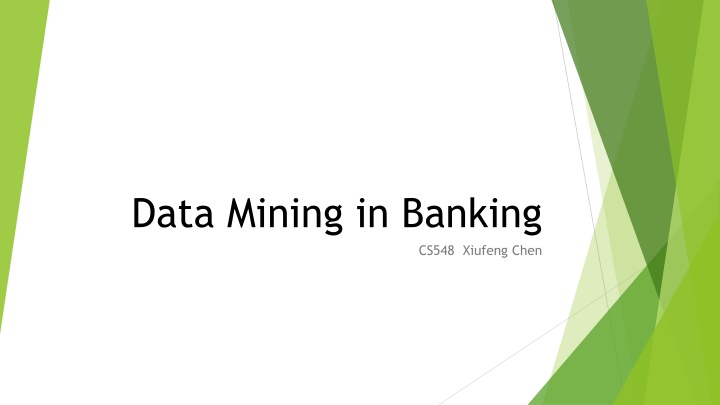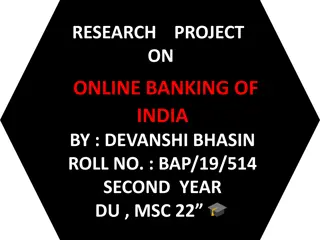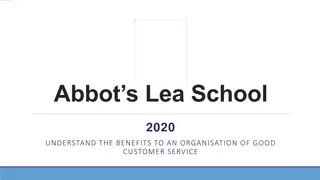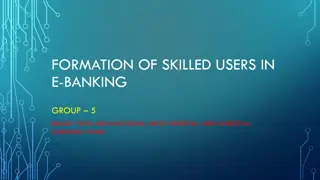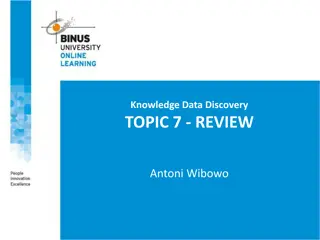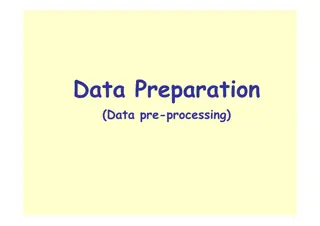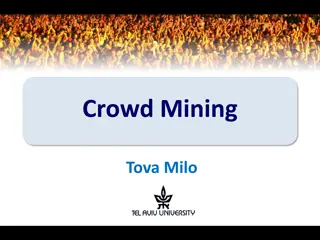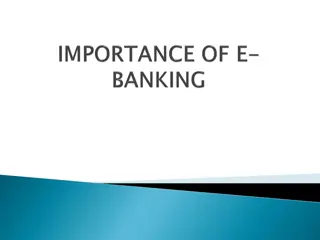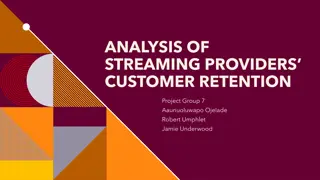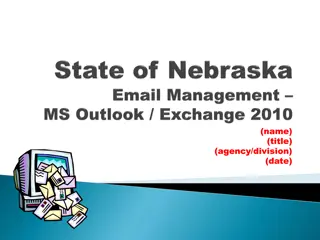Data Mining in Banking: Insights and Applications in Customer Retention
Data mining techniques play a crucial role in the banking sector, enabling banks to discover new customers, retain existing ones, manage risks effectively, and optimize operations. This analysis showcases how data mining is utilized in banking, including case studies from notable financial institutions like Bank of America.
Download Presentation

Please find below an Image/Link to download the presentation.
The content on the website is provided AS IS for your information and personal use only. It may not be sold, licensed, or shared on other websites without obtaining consent from the author.If you encounter any issues during the download, it is possible that the publisher has removed the file from their server.
You are allowed to download the files provided on this website for personal or commercial use, subject to the condition that they are used lawfully. All files are the property of their respective owners.
The content on the website is provided AS IS for your information and personal use only. It may not be sold, licensed, or shared on other websites without obtaining consent from the author.
E N D
Presentation Transcript
Data Mining in Banking CS548 Xiufeng Chen
Sources K. Chitra, B.Subashini, Customer Retention in Banking Sector using Predictive Data Mining Technique, International Conference on Information Technology, Alzaytoonah University, Amman, Jordan, www.zuj.edu.jo/conferences/icit11/paperlist/Papers/ Dr. B. Subashini Data Mining Techniques and its Applications in Banking Sector. Website: www.ijetae.com Boris Kovalerchuk, Evgenii Vityaev, DATA MINING FOR FINANCIAL APPLICATIONS Petra Hunziker, Andreas Maier, Alex Nippe, Markus Tresch, Douglas Weers, and Peter Zemp, Data Mining at a major bank: Lessons from a large marketing application http://homepage.sunrise.ch/homepage/pzemp/info/pkdd98.pdf Rene T. Domingo, APPLYING DATA MINING TO BANKING http://www.rtdonline.com/BMA/BSM/4.html Predicting Returns from the Use of Data Mining to Support CRM http://insight.nau.edu/downloads/CRM%20Mining%20Returns%20Paper.pdf
Purposes of Data Mining in Banking As banking competition becomes more and more global and intense, banks have to fight more creatively and proactively to gain or even maintain market shares. 1. Discover new customers. Clustering different customers into some clusters. 2. Remain customers. Especially the VIP customers. In general, 20% of customers bring 80% of revenues. Using association rules can find association between services. 3. Risk Management. Using decision tree to classify high risk people.
Bank of America Bank of America identified savings of $4.8 million in two years (a 400 percent return on investment) from use of data mining analytics. (source: Bank of America) This analyzing method was used to allow Bank of America to detect fraud and find eligible low- income and minority customers to ensure B of A s source: Bank of America compliance with the Fair Housing Act.
Flow of data mining technique Problem Understanding Data Understanding Data Filtering System Modeling System Evaluation Analyzing Results Source: Customer Retention in Banking Sector using Predictive Data Mining Technique
Preprocessing the data Customer relationship management (CRM): is a strategy that can help bank to build long- lasting relationships with their customers and increase their revenues and profits. Source: Predicting Returns from the Use of Data Mining to Support CRM
CRM Source: Predicting Returns from the Use of Data Mining to Support CRM
Discover new customers k-Means: k-Means is a distance-based clustering algorithm that partitions the data into a predetermined number of clusters. Each cluster has a centroid (center of gravity). Cases (individuals within the population) that are in a cluster are close to the centroid. For example, segment customer profession data into clusters and rank the probability that an individual will belong to a given cluster, and give them banking services they might need.
Remain the number of customers 1) measurement of customer retention; 2) identification of root causes of defection and related key service issues; 3) development of corrective action to improve retention. Apriori: Apriori performs market basket analysis by discovering co-occurring items (frequent itemsets) within a set. For example, find the items or attributes which comes from the lost customers and specify their association rules. Therefore, the bank can take much care of those customers.
Risk Management In this approach, risk levels are organized into categories based on past default history. Decision Tree technique can be used to build models that can predict default risk levels of new loan applications. 1. Credit Cards 2. Deposits Savings A/C 3. Internet Banking 4. Housing Loans 5. Term Loans 6. Cheque / Demand Drafts 7. Cash Transactions 8. Cash Credit A/c(Types of Overdraft A/C] 9. Advances 10. ATM / Debit Cards
Conclusion Data Mining techniques are very useful to the banking sector for (1) better targeting and acquiring new customers, (2) most valuable customer retention, (3) automatic credit approval which is used for fraud prevention, fraud detection in real time, (4) providing segment based products, (5) analysis of the customers, (6) transaction patterns over time for better retention and relationship, (7) risk management and marketing.
The End Xiufeng Chen
